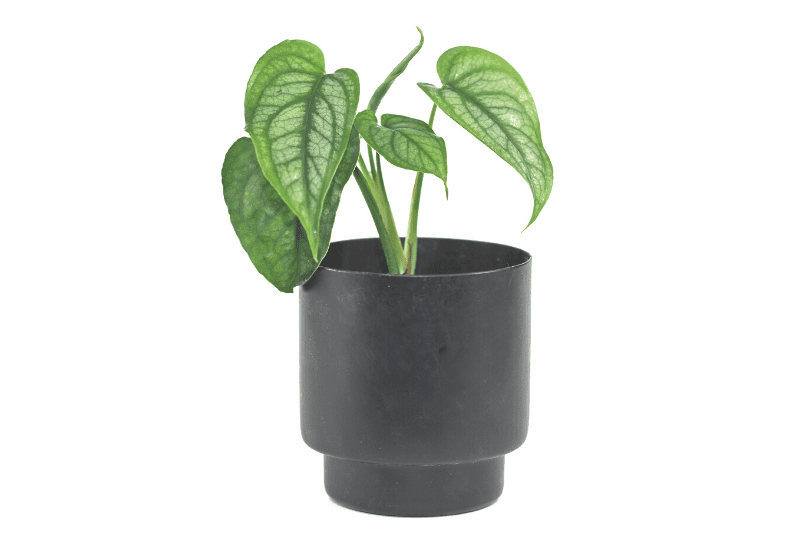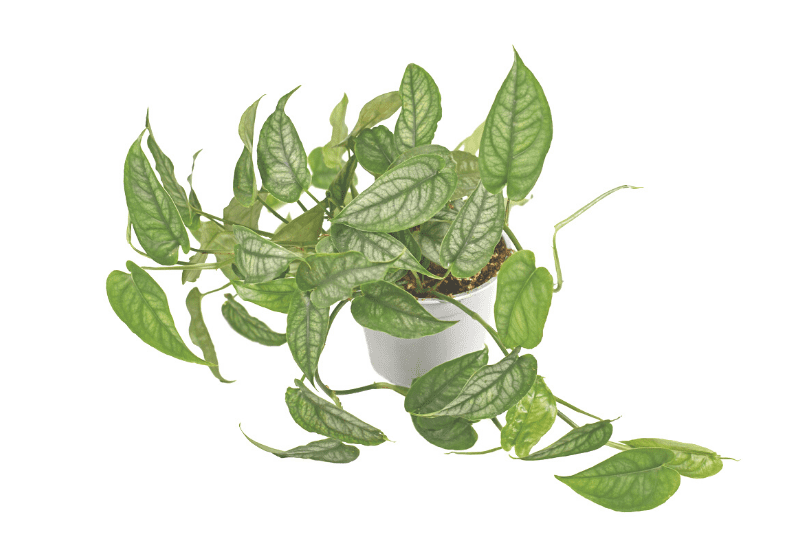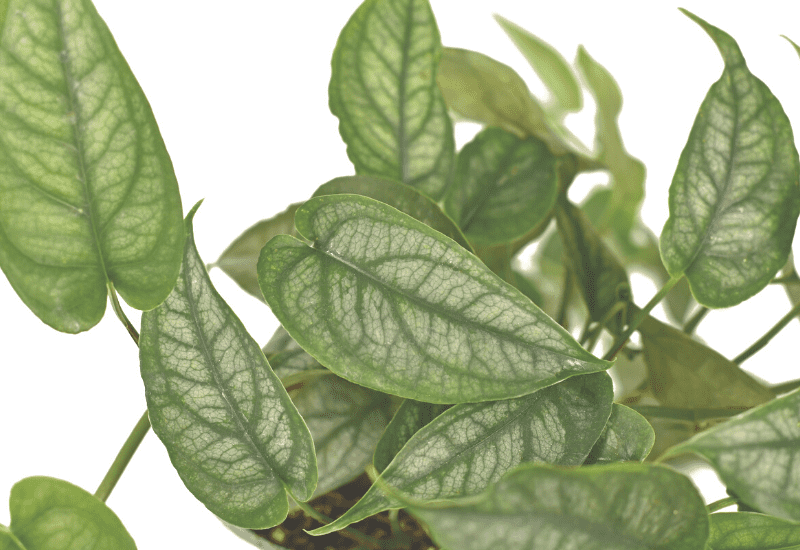The humorously and ominously nicknamed plant called the silver monster, known by plant lovers as the Monstera Siltepecana is a rare variety of climbing plant that is a snap to grow as a houseplant. They can reach astonishing heights in their natural habitat, climbing to the tops of trees.
But as a houseplant, they are content to trail languidly as they show off their picturesque silvery-veined leaves of youth that give way to the full-grown plant’s darker green version that develops its signature holes.
Monstera Siltepecana Care Guide Overview
- How To Plant (when & where)
- How To Grow (staking, watering, fertilizing, humidity, mulching)
- How To Trim And Prune
- How To Pot And Repot
- How To Propagate (when & how)
- And Pests and Diseases, Plant Species, Companions, Toxicity
Characteristics
- Scientific name and common names: Monstera Siltepecana, silver monster, hurricane plant, Mother-in-law plant, Swiss cheese plant, window leaf plant
- Origin: Mexico and Central America
- Indoor or Outdoor plant: indoors or outdoors in zones 9B-11
- Height and Structure: stems can be trailing and will reach 25cm in length; leaves can grow to the size of dinner plates; adult houseplants can grow up to 8 feet and outdoor plants are able to climb to the tops of trees
- Temperature: 50-95 F
- Flower Color: creamy white spadix inflorescence
How to Plant a Monstera Siltepecana

Planting Time
This rare tropical beauty’s growing season is during the spring and the summer, so planting is best done just before or at the start of this time. Since the Monstera Siltepecana is commonly grown as a houseplant, indoor plants should be given time to root and strengthen prior to the growing season, but outdoor plants will thrive quickly in the right environment.
Spacing
The silver monster plant doesn’t like to be crowded so for house plants; they should be potted with room to spread out their wide leaves comfortably. Outdoor silver monsters can be planted closer together if they are given a vertical structure to climb. Leaves of the silver monster can be up to 5 inches in length on a mature plant once it grows to its full maturity, so the spacing of the plant indoors or out should take this size into consideration.
Light
One of the best parts of growing an epiphytic creeper like the window leaf plant is that it only needs bright light to be happy. This plant naturally occurs on the forest floor, underneath a canopy of trees, and so it does not need or do well indirect light. Instead, it expects bright, filtered light to be happy, making it a perfect fit as a houseplant.
In addition, the leaves have an unusual characteristic called fenestration which means they develop holes as they grow. The purpose of the holes is for the leaf to broaden to a larger size, allowing the plant greater sunlight exposure without expending more energy. Indoor plants should be placed near a sunny window without being directly in the sunlight.
If the window leaf plant needs more sun, its leaves will not only reach toward the light source but may also not develop new leaves, the leaves may be smaller, or the mature plant will not produce leaves with the fenestrations or holes in them.
Plants that are in direct sunlight too long show their discontent with the browning of leaves that are scorched from the direct sun exposure. Outdoor plants should be placed where they will receive filtered sunlight at all times.
Soil
As a tropical plant, the silver monster requires a specific kind of soil texture to be happy: one that drains exceptionally well. The Monstera Siltepecana should be planted in loose, well-draining soil that is full of nutrients. This plant needs soil that is fortified with elements that assist in water drainage, like pumice, pearlite, and bark since sitting in wet soil can result in root rot.
Compacted soil is also disliked by this plant, but light soil that allows water to flow freely away from the silver monster plant will help make this plucky tropical plant happy. Outdoor plants should also be placed in soil that is nutrient fortified, well-draining, and non-compacted for a container plant.
How to Grow a Monstera Siltepecana

Growth habits
This plant lovingly referred to as the silver monster, partially earns its memorable moniker with its ability to grow astronomically if given the right circumstance. While houseplants and most outdoor plants will not end up growing up to the treetop level that Monstera Siltepecana is capable of in its natural jungle habitat, this plant can grow remarkably with a minimal amount of attention.
Indoor plants that are given the right environment are likely to grow up to 8 feet tall from a baby plant within a few years. Outdoor plants with appropriate bright light and care can mature in a few growing seasons to reach upwards to the tops of their support stake or tree.
When the Monstera Siltepecana is a young plant, the leaves take on the silvery sheen mentioned in its nickname. But when it matures, the color deepens into a purer green and the leaves spread out as they grow, eventually developing holes and slits in the leaves, giving rise to the nicknames “Swiss cheese plant” and “window leaf plant.”
When the mature plant leaves reach this stage, they have enlarged up to the size of dinner plates, usually within a few years of sustained growth.
Staking
Known as an epiphytic creeper, the Swiss cheese plant begins its growth cycle with creeping tendrils outward from underneath the canopy of trees of its natural habitat. But once it is a healthy young plant, it begins to search upwards towards a vertical support system.
As a houseplant, this climbing plant must have a stake for support. Indoor plants, supported with a stake, will happily wind upwards as well as towards light sources. Outdoor plants should be placed nearby a vertical stake or support for the most content plant as well since this also mimics their natural environment the most.
A stake gently covered in moss can be an attractive stake option for both indoor plants and outside specimens if needed.
Watering
One of the things that makes this plant so desirable as an indoor houseplant is the fact that it is not as finicky with watering as other tropical plants. The silver monster needs to be kept in moist but not soggy soil. To determine if the plant needs watering, a quick check of the topsoil with a fingertip will reveal if the upper layers of the soil are damp or dry.
This tropical beauty should be given a good drink of water when the top layers are becoming dry with clean, filtered water if possible. Using chlorinated or treated water is not preferable. If treated water is the only option for this plant, water can be left in a vessel uncovered overnight to allow for some of the chemicals to evaporate from it before using the water on the tender tropical plant.
Since the Monstera Siltepecana requires moist soil, a good estimation is to water it once a week during the growing season after the “finger test” has shown that the soil needs moisture. A good indication that the plant has gone too long between waterings is to look at the leaves.
If the leaves have curled up on the edges or turned yellow, there is a good chance that the silver monster plant has been allowed to become too dry between waterings.
Fertilizing
If the silver monster plant is placed in the right environment, it will not need much fertilizer to be content. However, during the growing seasons of spring and summer, liquid fertilizer can be applied once a month to maximize the health of the plant.
Humidity
Tropical plants typically love a warm, humid environment, and the Monstera Siltepecana is no different. This exotic plant loves a high humidity environment, but most homes with conditioned air naturally run lower on humidity than the sliver monster prefers. So, owners will need to provide extra humidity for this plant to thrive.
One way to do this is to place the plant in a higher-humidity location like near a bathroom windowsill. Another way to raise the environment’s humidity to the 60-90% that this tropical plant needs is to use a humidifier. This solution works well when the silver monster plant has companion plants that also need high humidity to be happy as well.
Some plant owners like to use the pebble method to raise the humidity levels around a tropical plant. To use this method, a tray of small pebbles is filled with water and placed underneath the plant. The proximity of the moisture transfers to the drainage holes of the potted silver monster plant as long as the pebble tray is monitored regularly for water. Owners can also spray the leaves of this tropical plant regularly to increase the humidity levels as well.
Mulching
The Monstera Siltepecana plant thrives in soil that is loosely packed and drains well, so adding mulch to cover the base of this plant is not necessary. If mulch is used in landscaping an outdoor silver monster plant, special care should be taken to make sure the plant continues to receive plenty of water and doesn’t dry out underneath the loosely packed mulch.
Trimming and Pruning
The vining Monstera Siltepecana needs very little trimming or pruning as a rule. Any leaves that have browned or yellowed can be removed, but otherwise, the plant will not need to be pruned back on a yearly basis. Indoor plants may be pruned for size consideration and climbing plants both indoors and out maybe pruned when the vertical climbing is problematic or needs training towards a specific stake height.

Pot and Repotting
When potting a baby silver monster plant initially, choosing a sturdy pot of terracotta or other similarly strong materials is key. The plant will need to be repotted when the root ball is visible, and a pot of one or two sizes larger than the plant is currently growing out of should be chosen to allow for future growth. When repotting, replace the growing stake with a larger one, if possible. A taller stake may be swapped in to promote potential heights to be reached by this industrious climber.
Propagation
The easiest way to propagate these enthusiastic growers is to use the cuttings method. To do this, locate a node (a nubby spot) on a stem of a mother plant and carefully prune the stem just below the node. Take the cutting, including any leaves above the node, and place the stem into water. Once it grows visible roots of a few inches in length it is ready to be planted into prepared soil and treated as a tender, baby plant.
Pests and Diseases
This tropical beauty is not likely to have a big problem with pest infestation, but a few bugs may make an appearance on some Monstera Siltepecana plants. One common pest that likes this exotic plant is the fungus gnat. This tiny pest lays its eggs on the soil when it is allowed to become overly soggy. Ridding the plant of these bugs is as simple as removing the top few inches of soil and replacing it with fresh, clean soil.
Another pest that commonly finds the silver monster plant is the scale bug that leaves evidence of its infestation through a powdery residue left on leaves. Removal of scale bugs can be completed by removing infected leaves (or even the bugs themselves, if only a few have moved onto the plant.) Regular spraying with Neem oil is a good way to avoid pests like scale bugs altogether. Spider mites and thrips are also potential pests to watch out for as they both love the silver monster plants as well.
If the plant is allowed to dry out too much, then mites and thrips will move in as they both thrive in hot, dry areas. Removal of affected leaves through careful pruning is the best way to rid the plant of these pests and keeping the silver monster plant appropriately watered should keep them from reinfesting the plant as well.
Plant Species
Noteworthy species
With over 45 varieties of plants in the Monstera family, plant lovers enjoy having quite a few different types of these attractive and relatively easy to own plants.
The Monstera acuminata is a loved specimen in this family because it can tolerate lower temperatures than the silver monster, adding versatility for outdoor planting in some areas.
Other popular varieties are the Monstera deliciosa as it resembles the Mexican breadfruit plant as well as the Monstera karstenianum since it is happiest as a hanging plant.
Companions
What are good neighbors?
As a tropical plant that needs high humidity, the philodendron family of plants is an excellent companion for the Monstera Siltepecana. As a tropical plant that naturally lives under a tree canopy before climbing upward, this plant is also a good outdoor companion for hardy, strong trees.
Toxicity
Is the plant toxic?
Yes, if ingested the Monstera Siltepecana can be harmful and can cause nausea and vomiting. In addition, the sap can cause skin irritation so contact with the skin should be avoided.
Is it toxic for cats or dogs?
Yes, similar to humans, pets should not be allowed to eat or interact with this plant. Animals may be nauseous or vomit when this plant is ingested and may develop skin irritation if they come into contact with the sap produced from the stems.


